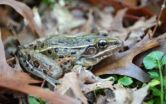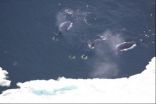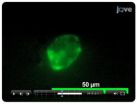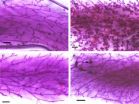(Press-News.org) In the wilds of New York City--or as wild as you can get that close to skyscrapers--scientists have found a new leopard frog species.
For years, biologists mistook it for a more widespread variety of leopard frog.
While biologists regularly discover new species in remote rainforests, finding this one in ponds and marshes--sometimes within view of the Statue of Liberty--is a big surprise, said scientists from the University of California, Los Angeles; Rutgers University; the University of California, Davis and the University of Alabama.
"For a new species to go unrecognized in this area is amazing," said UCLA biologist Brad Shaffer, formerly at UC Davis.
Shaffer's research is funded by the National Science Foundation's (NSF) Division of Environmental Biology.
In recently published results in the journal Molecular Phylogenetics and Evolution, Shaffer and other scientists used DNA data to compare the new frog to all other leopard frog species in the region.
"Many amphibians are secretive and very hard to find, but these frogs are pretty obvious animals," said Shaffer.
"This shows that even in the largest city in the U.S., there are still new and important species waiting to be discovered."
The researchers determined the frog is an entirely new species. The unnamed frog joins a crowd of more than a dozen distinct leopard frog species.
The newly identified wetland species likely once lived on Manhattan. It's now only known from a few nearby locations: Yankee Stadium in the Bronx is the center of its current range.
Lead paper author Cathy Newman, now of Louisiana State University, was working with Leslie Rissler, a biologist at the University of Alabama, on an unrelated study of the southern leopard frog species when she first contacted scientist Jeremy Feinberg at Rutgers University in New Jersey.
Feinberg asked if she could help him investigate some "unusual frogs" whose weird-sounding calls were different from those of other leopard frogs.
"There are northern and southern leopard frogs in that general area, so I was expecting to find one of those that for some reason had atypical behaviors or that were hybrids of both," Newman said.
"I was really surprised and excited once I started getting data back strongly suggesting it was a new species. It's fascinating in such a heavily urbanized area."
Feinberg suspected that the leopard-frog look-alike with the peculiar croak was a new creature hiding in plain sight.
Instead of the "long snore" or "rapid chuckle" he heard from other leopard frogs, this frog had a short, repetitive croak.
As far back as the late 1800s, scientists have speculated about these "odd" frogs.
"When I first heard these frogs calling, it was so different, I knew something was very off," Feinberg said.
"It's what we call a cryptic species: one species hidden within another because we can't tell them apart on sight. Thanks to molecular genetics, people are picking out species that would otherwise be ignored."
The results were clear-cut: the DNA was distinct, no matter how much the frogs looked alike.
"If I had one of these three leopard frogs in my hand, unless I knew what area it was from, I wouldn't know which one I was holding because they all look so similar," Newman said. "But our results showed that this lineage is very clearly genetically distinct."
Mitochondrial DNA represents only a fraction of the amphibian's total DNA, so Newman knew she needed to do broader nuclear DNA tests to see the whole picture and confirm the frog as a new species. She performed the work at UC Davis.
Habitat destruction, disease, invasive species, pesticides and parasites have all taken a heavy toll on frogs and other amphibians worldwide, said Rissler, currently on leave from the University of Alabama and a program director in NSF's Division of Environmental Biology.
Amphibians, she said, are great indicators of problems in our environment--problems that could potentially impact our health.
"They are a good model to examine environmental threats or degradation because part of their life history is spent in the water and part on land," Rissler said. "They're subject to all the problems that happen to these environments."
The findings show that even in densely-populated, well-studied areas, there are still new discoveries to be made, said Shaffer. And that the newly identified frogs appear to have a startlingly limited range.
"One of the real mantras of conservation biology is that you cannot protect what you don't recognize," Shaffer said. "If you don't know that two species are different, you can't know whether either needs protection."
The newly identified frogs have so far been found in scattered populations in northern New Jersey, southeastern mainland New York and on Staten Island.
Although they may extend into parts of Connecticut and northeastern Pennsylvania, evidence suggests they were once common on Long Island and other nearby regions.
They went extinct there in just the last few decades. "This raises conservation concerns that must be addressed," said ecologist Joanna Burger of Rutgers University.
"These frogs were probably once more widely distributed," Rissler said. "They are still able to hang on. They're still here, and that's amazing."
Until scientists settle on a name for the frog, they refer to it as "Rana sp. nov.," meaning "new frog species."
INFORMATION:
Hiding in plain sight, new frog species found in New York City
Leopard frog's habitat covers very small region, likely went extinct in larger territory
2012-03-19
ELSE PRESS RELEASES FROM THIS DATE:
Checking off symptoms online affects our perceptions of risk
2012-03-19
You've been feeling under the weather. You Google your symptoms. A half-hour later, you're convinced it's nothing serious—or afraid you have cancer. More than 60 percent of Americans get their health information online, and a majority of those decide whether to see a doctor based on what they find. "Wow, this is an era of self-diagnosis," thought Arizona State University psychologist Virginia Kwan, learning that statistic. How might information accessed online affect individual health decisions?
In a new study, Kwan and her colleagues found that the way information is ...
Researchers uncover molecular pathway through which common yeast becomes fungal pathogen
2012-03-19
TORONTO, ON—Scientists at the University of Toronto have found a molecular mechanism that plays a key role in the transition of Candida albicans yeast into disease-causing fungus—one of the leading causes of hospital-acquired infection. The finding highlights the importance of heat in fungal growth, and provides a new target for drug therapies to counter Candida albicans infection.
Candida albicans is a normally harmless yeast that is present in all humans. It becomes infectious in various genetic and environmental conditions, with temperature as a key determinant. It ...
Increase in Arctic shipping poses risk to marine mammals
2012-03-19
NEW YORK (March 16, 2012)—A rapid increase in shipping in the formerly ice-choked waterways of the Arctic poses a significant increase in risk to the region's marine mammals and the local communities that rely on them for food security and cultural identity, according to an Alaska Native groups and the Wildlife Conservation Society who convened at a recent workshop.
The workshop—which ran from March 12-14—examined the potential impacts to the region's wildlife and highlighted priorities for future management of shipping in the region. The meeting included participants ...
Glacier-fed river systems threatened by climate change
2012-03-19
Glacial meltwater increases biodiversity in mountainous freshwater ecosystems. As glaciers vanish due to global warming, so will those species dependent upon the icy runoff. This is the conclusion of a study authored by researchers from, among other institutions, the University of Copenhagen.
The article "Glacial river biodiversity" with the alarming new findings can be found in the journal Nature Climate Change.
"The knowledge is new and startling. Glacial runoff is cold, nutrient-poor and physically unstable, and therefore, typically species-poor. Traditionally, we ...
Researchers print live cells with a standard inkjet printer
2012-03-19
Researchers from Clemson University have found a way to create temporary holes in the membranes of live cells using a standard inkjet printer. The method will be published in JoVE, the Journal of Visualized Experiments, on March 16.
"We first had the idea for this method when we wanted to be able to visualize changes in the cytoskeleton arrangement due to applied forces on cells," said paper-author Dr. Delphine Dean.
She said other researchers have been using this method to print cells onto slides, but that they have only recently discovered that printing the cells ...
Study determines critical skills for PCPs to safely manage opioid risk in chronic pain patients
2012-03-19
The study's objective was to identify which skills and competencies are considered most critical for primary care providers (PCPs) to learn in order to effectively manage opioid risk in patients treated for chronic pain
Study participants included experts in primary care, pain management, and addiction
Experts in this study identified the most important skills for PCPs managing opioid risk in chronic pain patients as how to monitor opioids and how to assess for risk factors
Primary care physicians are faced with treating a large proportion of chronic pain patients, ...
Building the European Union's Natura 2000 -- the largest ever network of protected areas
2012-03-19
The European Union's Habitats Directive is now 20 years old, and its network of protected areas, known as Natura 2000, is nearing completion. After a slow start, the network now includes some 26 000 protected sites and covers approximately 18% of the EU's land surface as well as significant areas of sea. It is widely considered to be the world's largest network of protected areas based on agreed site selection criteria. The review has been published in the newly launched open-access journal Nature Conservation.
Douglas Evans, seconded to the Paris-based European Topic ...
Highly exposed to phthalates as fetuses, female mice have altered reproductive lives
2012-03-19
PROVIDENCE, R.I. [Brown University] — Female mouse fetuses exposed to very high doses of a common industrial chemical that makes plastics more pliable develop significant reproductive alterations and precancerous lesions as they grow up, according to a new toxicology study conducted at Brown University.
The administered doses of MEHP, the chemical that results when animals metabolize the industrial phthalate DEHP, were much higher than any normal environmental exposure that people or animals would encounter, said Mary Hixon, assistant professor of pathology and laboratory ...
Sharing patents with competitors may encourage innovation, UB study suggests
2012-03-19
BUFFALO, N.Y. -- Firms that make a previously patented innovation accessible to competitors increase overall likelihood of improving upon that breakthrough while also raising profits for the original innovator and market welfare, according to a study by a University at Buffalo economist.
The practice of free-licensing -- giving up patent protection -- corresponds to an evolutionary step in the study of patents and their effect on innovation, says the study's author Gilad Sorek, assistant visiting professor of economics at UB.
"This research arose from the notion that ...
Response rate high for some patients with metastatic melanoma treated with vemurafenib
2012-03-19
TAMPA, Fla. (March 16, 2012) – An international team of researchers from the United States and Australia, including researchers at Moffitt Cancer Center in Tampa, Fla., have found that the oral BRAF inhibitor vemurafenib (PLX4032) when tested in a phase II clinical trial offered a high rate of response in patients with previously treated metastatic melanoma and who had the BRAF mutation. More than 50 percent of the patients in the trial had positive, prolonged responses and a median survival of almost 16 months.
The study was published in a recent issue of the New England ...
LAST 30 PRESS RELEASES:
Making lighter work of calculating fluid and heat flow
Normalizing blood sugar can halve heart attack risk
Lowering blood sugar cuts heart attack risk in people with prediabetes
Study links genetic variants to risk of blinding eye disease in premature infants
Non-opioid ‘pain sponge’ therapy halts cartilage degeneration and relieves chronic pain
AI can pick up cultural values by mimicking how kids learn
China’s ecological redlines offer fast track to 30 x 30 global conservation goal
Invisible indoor threats: emerging household contaminants and their growing risks to human health
Adding antibody treatment to chemo boosts outcomes for children with rare cancer
Germline pathogenic variants among women without a history of breast cancer
Tanning beds triple melanoma risk, potentially causing broad DNA damage
Unique bond identified as key to viral infection speed
Indoor tanning makes youthful skin much older on a genetic level
Mouse model sheds new light on the causes and potential solutions to human GI problems linked to muscular dystrophy
The Journal of Nuclear Medicine ahead-of-print tip sheet: December 12, 2025
Smarter tools for peering into the microscopic world
Applications open for funding to conduct research in the Kinsey Institute archives
Global measure underestimates the severity of food insecurity
Child survivors of critical illness are missing out on timely follow up care
Risk-based vs annual breast cancer screening / the WISDOM randomized clinical trial
University of Toronto launches Electric Vehicle Innovation Ontario to accelerate advanced EV technologies and build Canada’s innovation advantage
Early relapse predicts poor outcomes in aggressive blood cancer
American College of Lifestyle Medicine applauds two CMS models aligned with lifestyle medicine practice and reimbursement
Clinical trial finds cannabis use not a barrier to quitting nicotine vaping
Supplemental nutrition assistance program policies and food insecurity
Switching immune cells to “night mode” could limit damage after a heart attack, study suggests
URI-based Global RIghts Project report spotlights continued troubling trends in worldwide inhumane treatment
Neutrophils are less aggressive at night, explaining why nighttime heart attacks cause less damage than daytime events
Menopausal hormone therapy may not pose breast cancer risk for women with BRCA mutations
Mobile health tool may improve quality of life for adolescent and young adult breast cancer survivors
[Press-News.org] Hiding in plain sight, new frog species found in New York CityLeopard frog's habitat covers very small region, likely went extinct in larger territory




